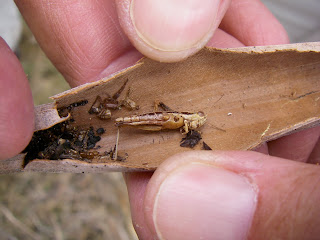The Florida Panhandle has an abundance of carnivorous and insectivorous plants. Of the 32 species of carnivorous plants found throughout Florida, 30 of these are found in the Panhandle. They can be found in areas of the marsh known as the wet savannas or seepage slopes. These savannas are known for their rich diversity, containing up to 50 plant species per square meter. These areas are often known to be pitcher plant prairies or pitcher plant bogs, named after the strikingly beautiful pitcher plants that grow there.
Carnivorous plants grow in wetland areas where the soils are acidic and low in nutrients. They capture prey and use digestive enzymes to absorb the nutrients. Although they do not depend on this adaptation for survival, these added nutrients stimulate leaf growth and the production of flowers and seeds.
PITCHER PLANTS
- Six species (from the genus Sarracenia) are found in Florida: White top (S. leucophylla),Southern (S. purpurea venosa), Parrot (S. psittacina), Sweet (S. rubra), Trumpet leaf (S. flava), and Hooded (S. minor)
- Pitcher plants are shaped like vases (or pitchers) and have nectar-producing glands to lure their prey to the rim of the structure where they slip on the surface of the plant and fall into the bottom of the "vase", where they are encompassed by digestive enzymes.
- Many animals, depend on pitcher plants for shelter or, in the case of certain moths, to help with reproduction by providing a place for the larvae to be housed.
- Pitcher plants require open, sunny areas to grow. Because of this, they are well adapted to fire and suffer from a lack of habitats with reduced burns.
- Human activity has reduced pitcher plant habitat by over 97% of original populations.
BLADDERWORTS & BUTTERWORTS
- There are fourteen species of bladderworts (Utricularia) and six species of butterworts (Pinguicula) in Florida.
- Bladderworts have several tiny bladders on the stems, each bladder containing a "trap-door" with a hair-triggering device. Once the device is triggered, a vacuum force pulls the prey inside.
- Several species of bladderworts are fully aquatic.
- Butterwort leaves are covered with stalked glands that secrete a sticky mucilage that help them capture small insects.
- Fun Fact: The leaves of butterworts were once used to curdle milk for the making of a sweet-tasting cheese, which is where the name butterwort is derived from.
- Florida has five species of sundews (Drosera).
- Genus name from Greek word "droseros", meaning "dewy, glistening in the sun."
- Leaves covered in glands on stalks that secrete liquid that looks like dew, but is sticky enough to entrap curious insects.
VENUS FLYTRAPS
- Several populations of the both exotic and endangered Venus flytrap (Dionaea muscipula) have become established in seepage slopes within the Apalachicola National Forest. The species is originally native to small area in North Carolina.
- The Venus flytrap use a unique timing technique to ensure that prey can be captured. Three trigger hairs inside the "mouth" of the flytrap act as triggers that once touched, a 20-second timer is set, and if another hair is triggered the Venus flytrap will snap shut, enclosing its prey inside its marginal teeth.






